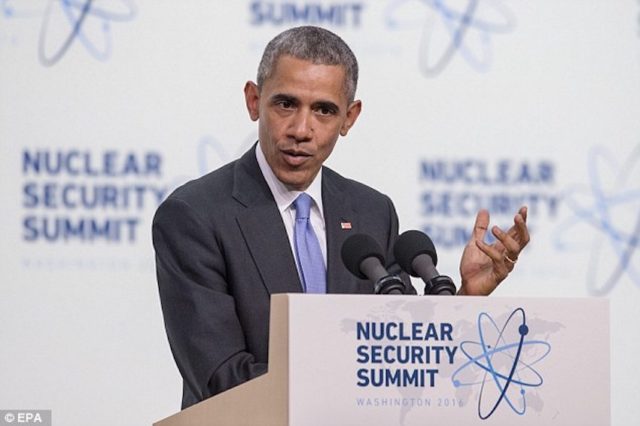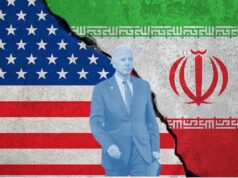
President Obama is not likely to foreswear potential U.S. first use of nuclear weapons before he leaves office, despite urging from some non-proliferation specialists that he do so. Good.
According to reporters David E. Sanger and William J. Broad the president, “who has weighed ruling out a first use of a nuclear weapon in a conflict, appears likely to abandon the proposal after top national security advisers argued that it could undermine allies and embolden Russian and China” (“Obama Unlikely to Vow No First Use of Nuclear Weapons,” The New York Times, Sept. 5, 2016).
The newspaper said Obama “considers a reduction in the role of nuclear weapons as critical to his legacy.” Arms control advocates “have argued for a series of steps to advance a pledge” the president made to “pursue ‘a world without nuclear weapons.’ An unequivocal no-first-use pledge would have been the boldest of those measures.” Arms controllers “contend that as a practical matter no American president would use a nuclear weapon when so many other options are available.”
Among those advocating a no-first-use pledge were Jeffery G. Lewis and Scott D. Sagan. Lewis directs the East Asian Nonproliferation Program at the Middlebury Institute of International Studies. Sagan is Caroline S. G. Munro professor of political science and senior fellow at the Center for International Security and Cooperation at Stanford University.
But their Washington Post Op-Ed, “The fix that U.S. nuclear policy needs” (August 25) ignored challenges to slowing, let alone halting nuclear weapons proliferation. For example:
They urged Obama to declare, “The United States will not use nuclear weapons against any target that could be reliably destroyed by conventional means.” Japan in early 1945 was being “reliably destroyed by conventional means” but to finish World War II that way, instead of by nuclear bombs at Hiroshima and Nagasaki, probably would have meant hundreds of thousands if not millions more American and Japanese deaths.
Lewis and Sagan did not appear to recognize that the Cold War, even including the wars in Korea and Vietnam, was fought and contained—comparatively speaking—under and by the umbrella of U.S. and U.S.S.R. nuclear weapons. America’s lack of a “no-first-use” policy might have contributed to Soviet restraint.
Neither did the Op-Ed writers provide historical context for international peace-making pledges. Such pledges may be kept by democracies and violated or renounced by dictatorships. This happened with Japan and Italy after the initially successful post-World War I agreements to limit naval rearmament and German remilitarization of the Rhineland in1936, in contradiction to the Versailles (1919) and Locarno (1925) treaties.
Russia even now—according to The Washington Post—is in violation of its Intermediate-Range Nuclear Forces treaty, and Iran transgresses U.N. sanctions on the building and testing of ballistic missile technology. North Korean violations or disavowals of agreements banning or limiting its development of nuclear weapons and ballistic missiles likewise raise a question over American no-first-use consideration.
“The fix that U.S. nuclear policy needs” failed to envision a world without nuclear weapons—or in which America changed all calculations by pledging no first use when (more prolonged, damaging and expensive) employment of conventional arms might do. Would this not be a world in which the biggest and/or most determined countries—China, Russia, Iran, North Korea—could, by means of large conventional forces, overawe smaller neighbors and divide America from allies? The New York Times gave credence to this possibility, reporting “in the end, Obama seems to have sided with his current advisers, who warned … that a no-first-use declaration would rattle allies like Japan and South Korea,” not to mention Israel.
A world in which the United States has issued a no-first-use vow also would be one in which countries with fewer constraints—North Korea and Iran come to mind—might assume that first use will get them what they want and the United States would decline to retaliate in kind because, well, what’s done is done. Far from discouraging aggressive or rogue countries, it would encourage them to test American resolve.
If Washington’s 2015 deal with Tehran guarantees Iranian nuclear weapons down the road, then a “no-first-use” vow on our part might be irrelevant at best, further destabilizing at worst. Sometimes creative ambiguity may actually just be creative.
“No-first-use,” as news coverage and commentary noted, appears to have been de facto U.S. policy after actual first use at Hiroshima and Nagasaki led to a quick end to World War II. But gains anticipated by advocates for making it de jure policy seem more aspirational than beneficial.
Those interested in braking nuclear proliferation might discuss more profitably Israel’s destruction of Iraqi and Syrian reactors, the Stuxnet virus and other sabotage, international banking restrictions, trade sanctions, missile defense and other means. “No-first-use” when conventional weapons “reliably” might do avoids harder questions, the first of which is tomorrow’s clouds over today’s “reliable” forecasts.
Lewis and Sagan asserted “it is hard to imagine a circumstance in which it would be either ethically responsible or strategically wise to use a nuclear weapon when a conventional one would suffice.” This sounded like straight-line extrapolation. Such circumstances may well be hard to imagine, here and now. But future circumstances by definition can be hard to imagine. Expecting to know, in an unexpected and unprecedented crisis, just when conventional weapons will suffice (would they be more destructive than nuclear arms, would they shorten or end a conflict, thus lessening or halting future casualties altogether?) sounds like the “presentism” syndrome, not analysis.





